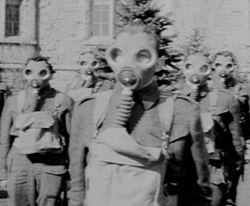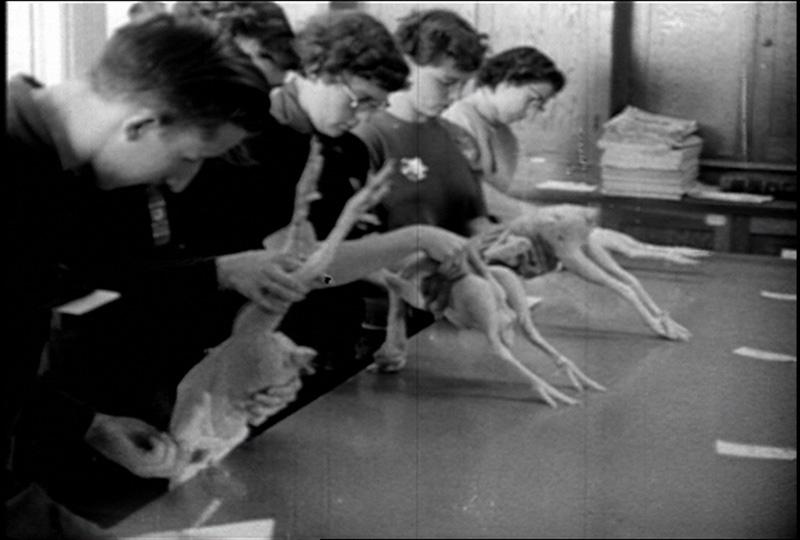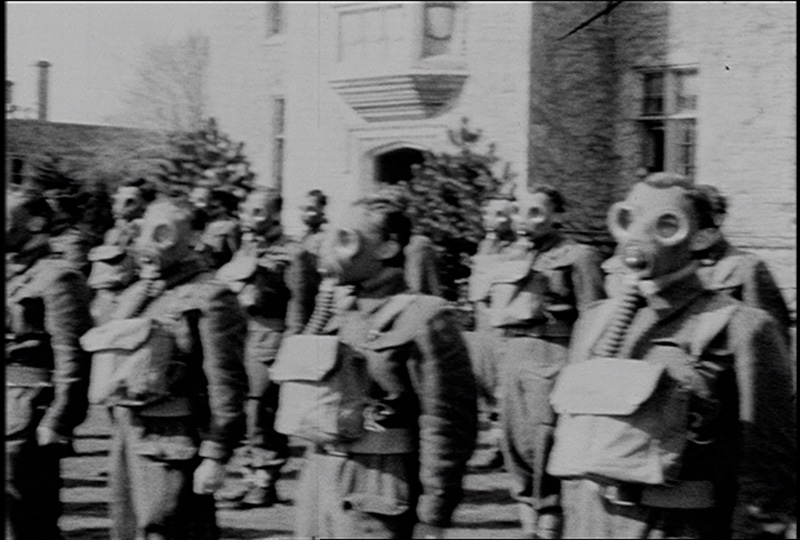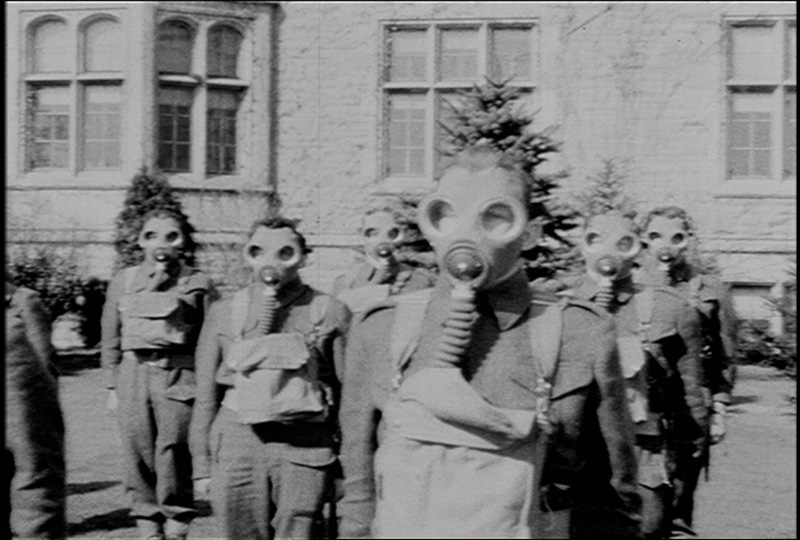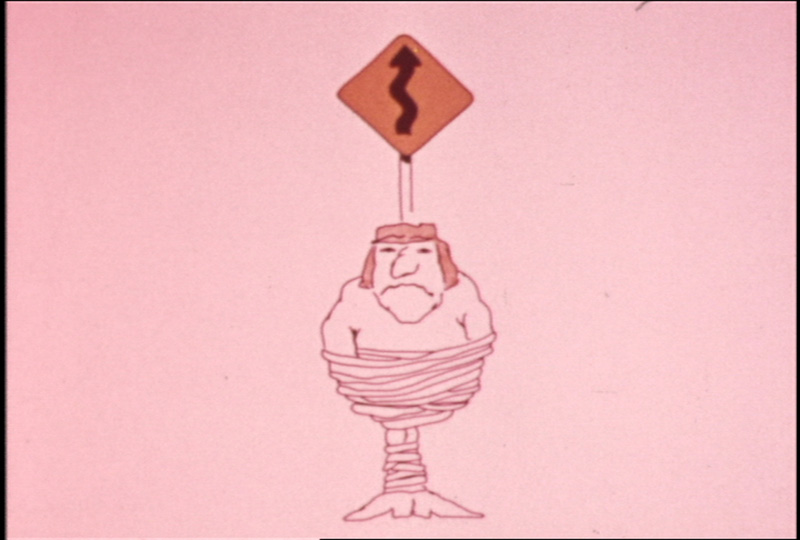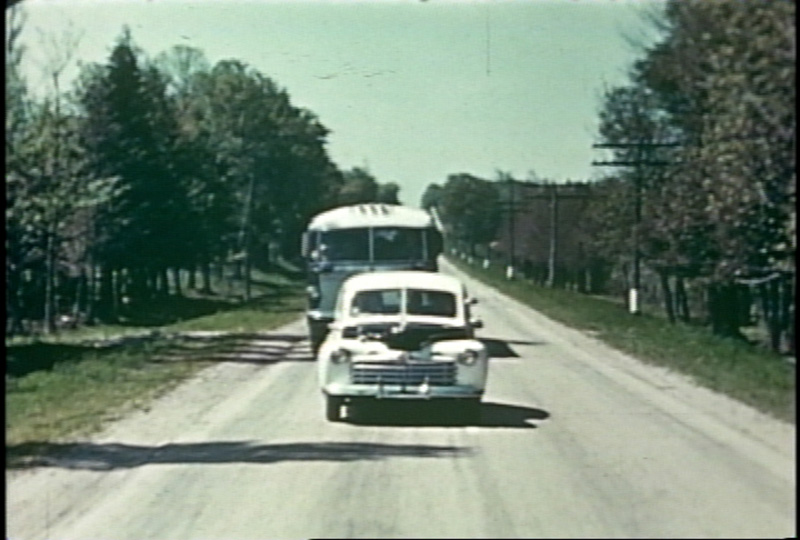Part of Fall 2007
Curated by Toronto artist Vid Ingelevics this unique look back into our provinces past will be presented over two evenings at OCAD. “ In the Public Interest was conceived in conjunction with the Archives of Ontario exhibition of still photography, Assignment to Archive: Recognizing the Work of Ontario Government Photographers presented from Oct. 2 – 26 at the John B. Aird Gallery, McDonald Block, 900 Bay St. (M-F, 10 – 6pm). This film component is drawn from many hours of public-interest films produced by the Ontario Government between the late 1940s and the 1980s. The screenings bring to light some of the fascinating range of material created on behalf of the province’s citizens. The first evening concentrates on films about agriculture and rural Ontario life, reflecting a dawning realization that Ontario’s population base was inexorably shifting from country to city. The second evening focuses on the government’s response to increasing postwar mobility by highlighting films dealing with travel, recreation and, inevitably, road safety. As with the still photography, some questions remain about who the audiences were for this material before it arrived at the Archives. Archives staff will be present to engage in discussion. (Vid Ingelevics)
Programme 1: Friday, October 12, 7 pm
C.O.T.C. (Canadian Officers Training Corps), 10:00, c.1940&lrquo;”1941, silent
Little metadata – film came from Ontario Agricultural College, Guelph (now U of Guelph) &lrquo;” grounds of the college are where the drills took place &lrquo;” no film title or credits &lrquo;” film title comes from original film can.
Ray Lawson News clip: Lieutenant Governor Opens International Plowing Matches, Kingston, Oct. 2:27,1947 silent
Lieutenant Governor opens International Plowing Matches, Kingston, Oct. 1947. This clip is excerpted from a single film that presents public events in the tenure of Lieutenant Governor Ray Lawson (1946-1952) in the style of a newsreel – the pre-television era means of disseminating news items in moving picture format in movie theatres.
30th Annual College Royal, 7:36,1954?
Like the other films that follow, this is a production of the Ontario Agricultural College, at the time part of the Ontario Department of Agriculture.
How to Press a Shirt in Five Minutes, 5:00, 1952
A production of the Ontario Agricultural College, at the time part of the Ontario Department of Agriculture.
Training Leaders, 22:15, 1954?
A production of the Ontario Agricultural College, at the time part of the Ontario Department of Agriculture.
How to Carve a Turkey, 4:00,1958?
A production of the Ontario Agricultural College, at the time part of the Ontario Department of Agriculture.
4-H Interclub Competitions, 10:52, 1955?
A production of the Ontario Agricultural College, at the time part of the Ontario Department of Agriculture.
Buying a Farm, 5:00, 1958
A production of the Ontario Agricultural College, at the time part of the Ontario Department of Agriculture.
Exodus from the Farm (interview excerpt), 4:36, 1964?
A production of the Ontario Agricultural College, at the time part of the Ontario Department of Agriculture.
How to Barbecue Chicken, 5:00, 1961
A production of the Ontario Agricultural College, at the time part of the Ontario.
Programme 2: Friday, October 19, 7 pm
U.S. Editors’ Goodwill Tours of Ontario, 1947 and 1948, 10:00 1947/48 silent
A series of annually produced films from 1947 to 1965, the U.S. Editors’ Goodwill Tours of Ontario recorded the annual tours of American newspapermen to Ontario sponsored by the Department of Travel and Publicity (now Ministry of Tourism). The films were intended to promote tourism in Ontario and the Department measured the success of its efforts by keeping track of the size of the articles written by the editors and the corresponding numbers of tourists that came to Ontario as a result.
Open Season, 19:00, 1970s
Produced by the Ministry of Natural Resources, the film uses a series still photographs with the gruff voiceover of the Ontario Provincial Park warden.
DHO Hunter, 1:00, ca. 1970
Department of Highways public service television ad.
DHO Road Signs, 1:00, ca. 1970
Department of Highways public service television ad.
Killarney Park Stock Shots, 2:00 1970s – early 1980s
Footage shot by the Ministry of Natural Resources.
Seat Belts, 30 sec, 1980s
Ministry of Transportation public service television ad.
Litterbug, 30 sec., 1960’s
Department of Highways public service television ad.
Defensive Driving, 30 sec., 1974?
Ministry of Transportation public service television ad.
Natural Journey, 22:50, 1980s
A Lloyd Walton creation, specifically created by the Ministry of Natural Resources for the Ministry of Tourism and Recreation to promote Ontario’s “natural” tourism destinations.
Metric Sign Changes (English & French versions), 2:00, 1977
Ministry of Transportation public service television ad.
Land of the Cree, 12:00, 1970s – early 1980s
Directed by Lloyd Walton
Programme Notes:
The two evenings of film screenings that make up the program, In the Public Interest, are related to the still photography exhibition, Assignment to Archives: Recognizing the Work of Ontario Government Photographers, currently on view at the John B. Aird Gallery, 900 Bay St in the McDonald Block of government buildings. That exhibition (on-going until Oct. 26) and these film screenings were curated more-or-less simultaneously over the past year. Notable in both cases was a consistent absence of certain kinds of metadata that could contribute a broader context for these productions. With the still photographs, the issues were often the anonymity of the photographers and the paucity of information about the nature of the assignments that motivated their taking. The films, while usually (but not always) having some form of credits built in, remain unknown to us in terms of audience. Where and how often were they shown? Who exactly saw them? Further research may uncover some answers but it does seem curious that this type of information about the films was often not seen to be worth compiling before they made their journey to the Archives.
That the scarcity of metadata contributes to a certain ambiguity around the use of these materials is confirmed in a recent review of the exhibition of still photographs by the Toronto Star’s Peter Goddard. He describes them as “unsettling and mystery-ridden, as if they were collected from a crime scene in a barely imaginable foreign country.” Goddard’s comments ably reflected my own sentiments about the films, in particular those from the Ministry of Agriculture, as I watched many hours of footage from Ontario Government filmmakers going back to the 1940s. My own family history &lrquo;” postwar immigration from the Baltic States &lrquo;” undoubtedly influenced my response to what I was seeing. The images and sounds of a far-from-secular Ontario, still deeply rooted in its agricultural heritage and colonial past, presented an unrecognizable place to me though I was born in Toronto in the 1950s.
By the mid-1950s the discrepancy between urban and rural population was already at about 4:1 and rapidly widening. The Oct. 12th screening reflect the intensity of the rootedness of Ontario rural life and values (the suited luminaries taking part in the plowing matches of 1947 had their recent counterparts recently when would-be provincial leaders McGuinty, Tory and Hampton presented themselves at this year’s version of the same event and tried to plow a straight furrow). However, by the early 1960s the films and their titles reflect that this way of life was changing. Financing difficulties, shrinking manpower and land speculation are offered as evidence in films such as Buying a Farm and Exodus From the Farm. The final short film in the first evening’s screening situates us in suburbia, barbecuing chicken in the backyard, on land that quite likely was farmed for generations.
While the first evening’s screenings are, in a sense, about the government and its filmmakers constructing an image of a certain sector of Ontario (for Ontarians?), the second evening broadens its focus to engage with the construction of an image of Ontario not only for us but for others outside of Ontario’s borders. Postwar mobility in Canada (i.e., Southern Ontario) and the United States was characterized by an explosion in car sales, an expansion of highway networks and a new appreciation in Ontario of the value of American and domestic tourism. Accompanying the increasing volumes of traffic (and garbage) on Ontario highways came a concomitant concern with educating Ontarians about road etiquette. Thus, tourism promotion, recreational issues, littering and safe driving are the subjects of the second evening’s screenings.
The films and short public service announcements of this program are set in a world far more familiar to me. In fact, I realized that the 1970s film, Open Season, made to train parks staff on how to pre-empt the carnage that partying youth was apparently inflicting on the province’s parks, identified precisely my demographic (at the time) as the enemy. The evening’s program begins, though, with a few excerpts from what became an annual, documented event from 1947 through 1965 &lrquo;” the U.S. Editors’ Goodwill Tours of Ontario. Shown are highlights from these yearly tours offered by the Department of Travel and Publicity (now Ministry of Tourism) to American newspapermen. Treated like royalty, with their own bus and O.P.P. motorcycle escort, this group toured to Ontario’s loveliest settings with much emphasis on fishing, golf and the smoking of rather substantial cigars. Excerpted segments show main border crossings with absolutely no traffic between the United States and Canada as well as an earnest demonstration of synchronized swimming for the U.S. editors’ benefit.
Open Season is essentially a slide show transferred to film with a voice-over and features still photography by Lloyd Walton. Walton went on to produce numerous films for the Ministry of Natural Resources, where he worked between 1970-1998, and the Ministry of Tourism and Recreation. His films are characterized by a lyrical, poetic approach. Walton, while speaking to Archives staff recently, commented on his approach as trying to counter public perceptions of “government films” as not being particularly well made. One of the ways he did this was to try to incorporate original music into his films, as in the early 1970s production, Land of the Cree, that featured the songs and voice of Archie Cheechoo, a Cree singer from Moose Factory. Walton’s films achieved reasonably wide distribution (and won awards). For example, Natural Journey (1980), which was one of his more popular efforts, was distributed by the National Film Board and translated into five languages. Walton also noted in recent conversation that, unfortunately, a lot of the background information on his films (production and distribution notes) hasn’t survived.
Punctuating the above-noted longer selections of the second evening’s screenings, just as they once did television programming of the late 1960s and 1970s, are memorable 30-second animations produced by Frank Hammond on the subjects of littering and the illicit shooting of highway road signs by hunters. Finally, it must be stressed that the films and animations that make up these two nights of screenings are but the tip of the iceberg of material produced in the public interest that now resides in the Archives of Ontario &lrquo;” “yours to discover” as our license plates admonish us year after year.
Vid Ingelevics October, 2007
Vid Ingelevics is a Toronto-based artist, writer, independent curator and teaches at the Ontario College of Art & Design and at Ryerson University. His artwork and curatorial projects have been shown in Canada, the US and Europe while his writing on art has appeared in Canadian Art, C magazine, Prefix Photo and other arts publications. For more information on Vid’s work please go to his website: www.web.net/artinfact.
Acknowledgment: I would like to note the work of Mark Epp, Senior Coordinator, Collections Management & Collections Development, the Archives of Ontario, in researching and organizing the film selection information that accompanies these screenings, parts of which have also been incorporated into my above text.
By Seth
Each of the films in this program is a relic from a vanished world – a world that increasingly seems distant and unconnected to this one.
Whether that world was real or a fiction constructed by the filmmakers is hard to determine from today’s vantage point. Certainly to our modern eyes it is an odd world. One gets the impression that this vanished Ontario was some sort of snowy gulag populated by well behaved 4H party members. Everyone seems properly disciplined and guided by the calm voice of the narrator/Big Brother.
I can’t help but think that this was the world the filmmakers were trying to will into existence. If the population would just iron a shirt properly or carve a chicken in just the right manner than perhaps a Northern utopia might spring into being. What a quintessentially dull Canadian utopia – polite, unassuming and tidy. Even in the later films from the sixties and seventies there appears to be a plea for us to all just “behave reasonably”. Stop littering and don’t drink so much beer (in those lovely stubby bottles)!!
Yet, despite the ordered voice of the narrator we can still catch glimpses of what must have been the real Ontario of the past. The sour faces of a crowd in Kingston or the streamlined cars lining the main drag in Goderich. (Was there ever REALLY a world filled with those massive beautiful machines?) Sometimes an image will fascinate &lrquo;” those rural landscapes, for example, that fill the centre section of HOW TO BUY A FARM. Who could have thought after it’s painfully stiff opening sequence that this film might contain such lovely and evocative images of the Ontario countryside. Isn’t it so typically Canadian that in many of these films it is the landscape that captivates more than the people?
I have to say that I usually have little patience for the modern tendency to laugh at the (apparently) unsophisticated media products of the past. Surely, our own times will look just as corny or embarrassing in a very short while. Still, there are times when you just have to let go and laugh at where you came from. Most of these shorts were deadly earnest in intent yet they can’t help but be humorous today. They are a window into a past that is frighteningly square and stuffy. An Ontario entirely composed of corny and boring old uncles.
Finally, these films have one other quality worth mentioning. A quality hard to pin down, something I’ve come to refer to as “sublime boredom.” I generally apply this description to works which manage to captivate you with their narrative slowness. What at first seemed dull turns out to be quite interesting. They are works which might best be watched at 4 in the morning while you are fading in and out of a half sleep. Come to think about it most of these films have that familiarity about them &lrquo;” as if you did see them once in a dream, or sometime long ago in childhood, or perhaps very early on a grey Sunday morning. Long before anyone else in the house was up. On some static-fuzzed northern TV station that was picked by chance by the antenna for an hour or so just before you were dragged off to church.
Seth is the pen name of Gregory Gallant, a Canadian comic book artist and writer. Born in Clinton, Ontario, Seth attended the Ontario College of Art in Toronto. Seth’s first published comics work was as an illustrator on the Vortex Comics series Mister X, but he soon moved to his own series, Palookaville (published by Drawn and Quarterly), which was part of a miniature boom in non-genre alternative comics from Canada in the 1990s.
